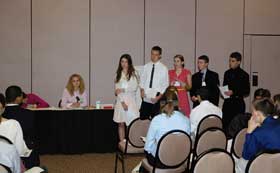For more archives, go to the Advance Archive/Search Page.
Model UN Teaches Students Art
of International Negotiation
Groups of high school students dressed in suits and skirts are engaged in earnest debate about world peace and the United Nations’ role in particular international issues. Presiding over the discussions, gavel in hand, are UConn undergraduate students.
The occasion is UConn’s sixth annual Model UN Conference, which took place Oct. 21-23 in the Rome Commons Ballroom, attracting more than 300 high school students from 15 high schools in three states.
The event is a learning experience for high school and college students alike.
“The Model UN experience helps students develop practical skills, including public speaking, parliamentary procedure, and organization,” says Betty Hanson, a professor of political science and the faculty adviser to UConn’s Model UN.
 |
High schoolers take part in a Model UN conference that is run by UConn students. |
The participants at the conference become delegates representing certain countries and they separate into different committees where they try, through mediated discussion, to solve the international issues they have previously researched at school. During breaks, many of them hover around computers to check facts and conduct further research to support their positions.
The main purpose of the conference is for the participants to come to a resolution and vote on it, says Erin Byrne, a senior majoring in political science, who helped organize the conference. Eventually a resolution happens naturally, she says, but it may take days – to the surprise of most students.
In each committee, the delegates vote on two issues, using position papers to help them decide on resolutions that are in the best interests of the countries they are representing. During the committee meetings, the delegates try to forge alliances by passing notes to each other. They then break up for caucuses, where they discuss the issues in smaller groups.
When members of the alliances have come together and written a working paper they think will solve the problem, they address the assembly and present their ideas for a vote.
All this is managed by undergraduate students.
“This is the best student activity to become involved in,” says Adam Porter-Price, a senior majoring in international relations who was this year’s UConn Model UN Secretary General. “Not only is it good to teach high school students about the United Nations, it also teaches college students how to manage responsibility and logistics very well.”
Porter-Price started participating in the Model UN program when he was in high school. Now he is so committed that for much of this semester, he spent about two hours a day working on the conference details.
Hanson says many of the 30 or so undergraduates who were organizers this year attended the Model UN as high school students. Many have said the fact that the University holds this conference and that they might have the opportunity to work on it was a factor in their decision to attend UConn.
She says that when undergraduates first proposed holding a Model UN at UConn, she initially tried to discourage it because she thought the logistics and details of organizing such a conference would prove to be more challenging than they could imagine.
But the students’ enthusiasm and hard work have not only kept the program up and running, but have also improved it. Because of the program’s positive reputation, attendance has grown each year – from 65 students the first year to more than 300 now.
The conference involves extensive preparation and planning. UConn students organizing the conference work with the high schools to develop a conference curriculum that blends with the high school curriculum for that year. Months ahead of time, the students begin discussions with high school faculty about critical issues, says Porter-Price. The group then formulates the discussion topics and papers around those issues.
Although high schools may attend more than one Model UN a year, teachers particularly value UConn’s program because the emphasis is placed on training the students, says Hanson. It is an introduction for high school students who have never participated in such a conference before. And because the conference is smaller than the Model UN’s held at Harvard and other colleges, there is a high level of involvement among the students who participate.
The UConn Model UN is geared toward younger students, and modifies parliamentary procedure so that freshmen and sophomores are not alienated from the process.
“First-year students in this program are often shocked at how much time is spent on such seemingly minor issues as the agenda,” Hanson says.
The Model UN program helps students understand why international agreement takes so long and why conflict is so pervasive, she adds, but it also shows them how to search for the common interests that provide the basis for cooperation.
Christopher Thomas, Hamden High School’s co-advisor, said during the conference that his school had fulfilled several of its academic goals with this program.
“There’s no bigger reward for a teacher than to see his students use what they are learning in the classroom in such an important and real way,” he said.
David Cross, also a co-advisor for Hamden High School, said the undergraduates who run the conference are outstanding. “Some conferences, although they are bigger, are run less professionally,” he said “The quality of the students running the conference makes a big difference.”

